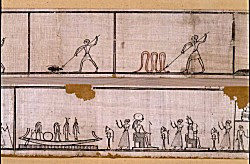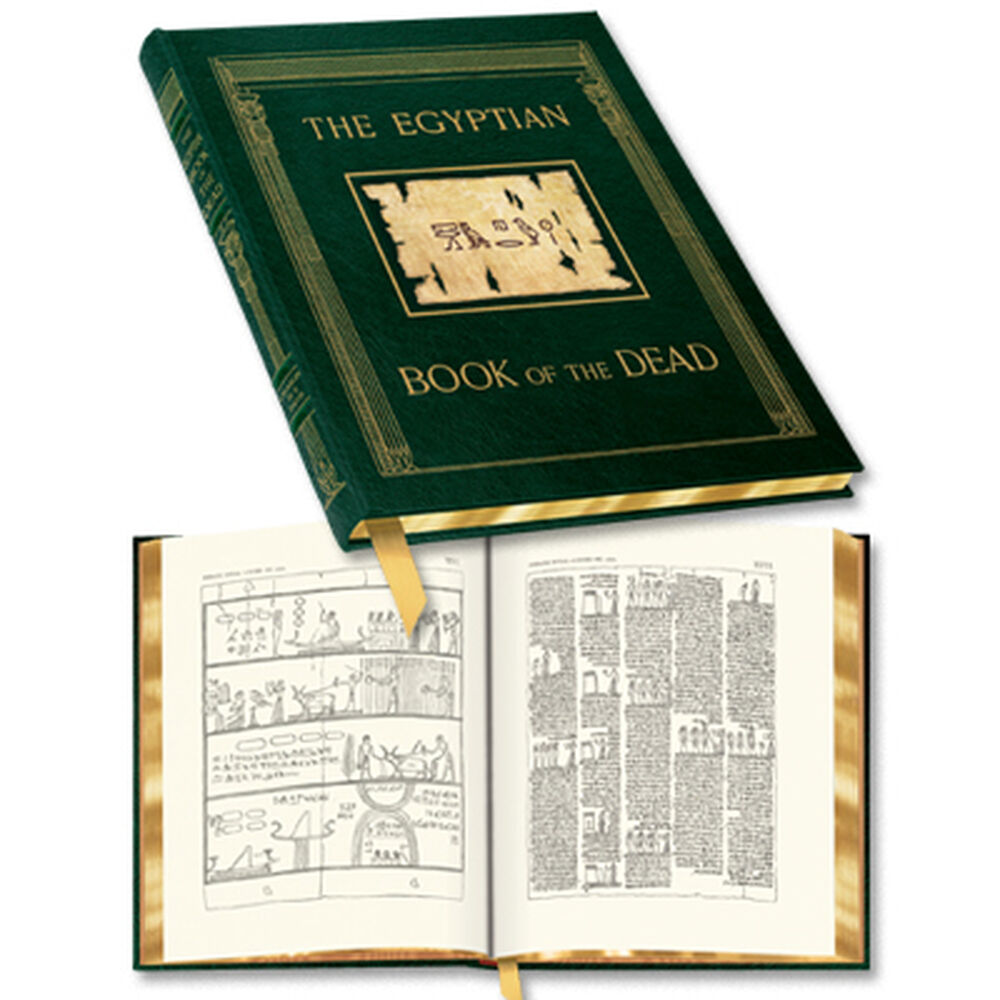Egyptian Underworld
Introduction to the Duat
The Egyptian underworld is important to understanding the history of hell for virtually all other world religions. It is referred to as the Duat (or occasionally referred to as the Amduat–“that which is in the Duat”), and is comparable to the underworld in other religions because it is a neutral place for the wandering dead. Much of what we know about the Duat was written around 2000 BC in what is commonly known as the Egyptian Book of the Dead. However, some feel the original concept of it may have even originated earlier than that. Though the idea of the Egyptian underworld evolved over time, some elements remained the same throughout the entire Egyptian kingdom.
The Book of the Dead
Though the Book of the Dead is perhaps the most famous of all the texts from ancient Egypt concerning the afterlife and the journey of the soul, there are many other texts that speak of a soul’s journey subsequent of death as well. However, our knowledge is quite limited in regards to the reliability of those writings because we do not currently possess a vast number of them. There are some texts that speak of the Duat and the punishment consigned to the individual in one manner, while another text may say something completely different. Essentially, there is not one single univocal idea to the afterlife in Egyptian Religion. Therefore, tracing the development of the concept of Egyptian afterlife is difficult, though not impossible. However, we do know particular common and general ideas and concepts from Egyptian religious thought thanks to a few well-preserved writings.
For example, the Egyptians always conceived the cosmos to exist in three tiers: the heavens, the earth, and the Duat (much like OT Hebrew cosmology which had the heavens, the earth, and Sheol). The Duat was not a place of punishment, though, because it is viewed similarly to the Kurnugia (the underworld in Mesopotamian religion from the last blog post which can be found HERE). It is instead described as a shadowy, gloomy place that is categorically not pleasant, but it is still not a place of eternal punishment and torment. There was a bit of hope for those consigned to the Duat, however, because there was indeed optimism that after one got through the complications of that place, they could eventually reach the Field of Rushes (or Field of Reeds) which is similar (though not identical) to a modern concept of a blissful state of existence, or rather, heaven.

The Path of Immortality
Much like Gilgamesh was in The Epic of Gilgamesh, the Egyptians were obsessed with immortality. They composed the Book of the Dead specifically for the dead to assist them in the afterlife with spells, prayers, incantations, secret passwords, and warnings for their trip into the realm of the dead. However, this was not for the ordinary Egyptian. The Book of the Dead was primarily for those wealthy enough to have a pyramid, coffin, or tomb. If one was lucky enough to have one of these reserved for them when they died, their chance at a better afterlife was immense. That is because one’s existence during the afterlife depends precisely on what is left in your tomb when you pass.
For example, tools were sometimes left to assist the person in the Field of Rushes (if they were lucky enough to make it there) and particularly in agricultural activities to help with food and to have a more pleasant afterlife. Likewise, small figurines were also left with the dead called shabti to act as the deceased’s slaves to do all the hard work. Pharaohs like King Tut, for example, had 414 shabti’s buried with him while other, less noble people may have one or two.
Judgment After Death
Though the afterlife in ancient Egypt is not quite the same as modern religions, there was the idea of judgment due to how one lived their life. Interestingly enough, the idea of judgment after death may have actually originated during this time in Egypt. To begin, after one died, their soul would first encounter the god Anubis who would escort the deceased into the Hall of Justice (Anubis is the famous jackal-headed monster typical in Egyptian art). In the Hall of Justice, the deceased will have a chance to plead their case for continued existence in the presence of the judge and god of the Duat, Osiris, who sits on a throne attended to by two other gods, Isis and Nephthys. No matter how much the person pleads their case, Osiris will eventually place their heart on a scale balanced on the other side by a feather from the headdress of Maat, goddess of truth. If their heart sinks lower than the feather, they will be devoured by the monster Ammit, and that would be the end of them. Total annihilation with no further existence in the afterlife.
If you somehow your heart is balanced with the feather you will then be allowed to survive and subsequently be ushered into the Field of Rushes, in your new body called a sahu. The troubles are not over, however, because there are still hazards such as crocodiles, snakes, giant beetles, as well as possible suffocation from lack of air that could conceivably still eliminate your sahu, since it is not inherently immortal. This is where the Book of the Dead comes in handy. Egyptians believed that if one is buried with the book, the deceased would be able to carry it with them to aid in their encounters with the troubles during their trip in the Duat. The spells and incantations contained within it are there to protect you from the various perils that await should you come across the difficulties outlined in the book. However, being buried with a copy of the Book of the Dead was not cheap by any means, and would typically only be buried with the nobility or the wealthy since they were the only ones able to afford a copy.
Transformation in the Duat
The end goal of the Book of the Dead in the afterlife, however, is to transform yourself into a bird similar to a falcon, phoenix, heron, or swallow. You could even potentially transform into a crocodile or snake, which symbolizes renewal and rejuvenation, even though they are deadly to a sahu in the afterlife. A final possibility could be that the deceased was transformed into a farmer where the aforementioned agricultural tools would prove helpful. This is the final resting place of the dead who made it thus far in Egyptian religion. It is not quite like the blissful existence of the concept of the Christian Heaven as is known today, but simply a continuation of life after death.

Sungod Ra
The Duat was not only a location for human souls. The Sungod Ra, one of the more powerful gods in all of Egypt, lives in the underworld and makes a daily trip up from the Duat to the land of the living to bring the sun into the sky. Egyptians thought the sun’s rising from the west was its ascent from the underworld and the setting in the east was its descent back to the Duat being carried along by Ra.
Despite being one of the most powerful gods, Ra still had to do daily battle with the evil Apep, a formidable opponent, in the form of a giant serpent. Though Ra always won, a rainy and stormy day could signify that Apep put up a larger fight than usual, where a nice sunny day was when Ra won easily. The souls resigned to the Duat, however, are pleased when Ra makes his descent back to the underworld because he carries the sun and brings the sunshine and lights up the underworld causing those who dwell within its boundaries to have at least a little joy.
Ba and Ka
The Egyptians were also dualistic in their theology due to their bifurcation of individuals whom were thought to consist of both the Ba (the physical part of the body), which was to remain pure after death, and the Ka (the spiritual component of the individual) that voyaged to the underworld on a boat ride from Ra. The Ba (body) could remain pure after death by mummification, which was why it was practiced so much in Egyptian times. Though, like having a personal Book of the Dead, mummification was only for the rich or powerful. The Ka would then go on a journey aided by the Book of the Dead, which ultimately led to the place of judgment where the aforementioned meeting with the judge Osiris is to take place. Though many have argued that a separate existence of body and soul was original to Plato, the Egyptians had a dualistic theology before Greek philosophers came to the forefront, though with slight differences.
Eternal Torment or Annihilation?
One thing we are certain about regarding the Duat is that the punishments are not unending and continuous. They are a one-time occurrence where the consequence will last for an eternity—much like many Christians who hold to annihilation view the afterlife. For example, another key text for understanding “hell” in Egyptian religion is the Book of Gates, which dates from the 13th-12th centuries BCE. In this text, creatures from the realm of the dead do, in fact, subject those who die to torments and, at times, dismemberments until the punishments render the deceased non-existent, never to have consciousness again. Fundamentally, ancient Egyptian belief concerning the fate of the damned is the denial of any conscious existence following death.
Another excellent example of this philosophy of total annihilation is evidenced from the late Egyptologist Wallis Budge, who has done substantial work regarding the Egyptian Book of the Dead (and several other key texts) in both understanding what it says along with its translation. Though now considered outdated, his translations of the texts, regardless, provide further clarity concerning how ancient Egyptians viewed “hell.” In his book Papyrus of Ani; Egyptian Book of the Dead, Budge translates a few critical texts specifically referencing annihilation. A few examples are as follows:
“Hail, Thoth, who didst make the word of Osiris to be true against his enemies, make thou the word of the Osiris, the scribe and assessor of the sacred offerings which are made to all the gods, Ani, to be true against his enemies, with the Tchatcha Chiefs who examine the dead on the night of making the inspection of those who are to be annihilated.”
“Now the great Tchatcha Chiefs who are present at the examination of the dead are Thoth, Osiris, Anpu and Asten (read Astes). Now the inspection (or, counting) of those who are to be annihilated signifieth the shutting up of things from the souls of the sons of revolt.”
Budge understood the Egyptians to believe in permanent death, with no hope of eternal life for the damned. There was no unending torture of wicked individuals and no eternal and continuous damnation—only death.
The Book of Gates
Similar to the Book of the Dead, another text called The Book of Gates likewise speaks of total annihilation for the damned. For example, this text expresses of the responsibility of the gods in the netherworld and how they are to manage the souls of the dead when it commands the gods “to place the spirits on their thrones; to deliver the dead to their judgment; to annihilate the bodies of the wicked; to restrain the souls…”
Later in the text, it has the gods expressing directly to the deceased and records the god Atum as saying to them, “you are called to endure an evil fate…your bodies are to be cut up, your souls destined not to exist.” The god Horus then further elaborates on the punishments by saying, “You are fettered from behind, you are the evil ones to be decapitated—you shall not exist! Your souls shall be annihilated and shall not live…” Then finally, Horus speaks to the fiery serpent and commands him on how to handle the dead when he demands:
“Distend your jaws, belch forth the flame among the enemies of my father, burn their bodies, consume their souls by this heat of your mouth, by the fire which is in your body! My children are against them, they annihilate their souls…they shall not exist! May the fire that is in the serpent come forth.”
It is clear from these, among many other texts, that an unending, eternal conscious torment of wicked souls was nowhere near ancient Egyptian religious thought. Therefore, the idea of the modern concept of “hell” was developed later, after the Egyptians.
Conclusion
The history of hell in the Egyptian religion is where the idea of judgment after death originates, as demonstrated by the scales of justice and the judge Osiris who resides in the Duat, to judge the disembodied souls of the deceased. The evolution of judgment in the underworld carries over to almost all religions after Egypt and is the most common denominator of all modern thought regarding punishment or rewards in the afterlife. The modern concept of “hell” as eternal torment did not originate in Egyptian mythology but was rather a product of much later thinking. Egypt believed in what is similar to Christianity’s theory of annihilationism where the soul (or person) is rendered extinct, and to never live again. However, it does appear that this is the time where judgment after death depending on one’s actions became a bit more clear to an ancient society.
Next blog post on the history of hell is the religion of Zoroastrianism found HERE.
Previous post on the Mesopotamian underworld, the Kurnugia, is found HERE.
Further Reading:
The Egyptian Realm of the Dead, www.symbolsage.com/duat-egyptian-realm-dead/
Turner, Alice K. The History of Hell. New York, NY: Houghton Mifflin Harcourt Publishing, 1993.
Crisafulli, Chuck and Kyra Thompson. Go To Hell: A Heated History of the Underworld. New York, NY: Simon and Schuster Publishing, 2005.


